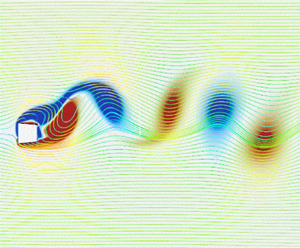Article contents
Critical effect of fore-aft tapering on galloping triggering for a trapezoidal body
Published online by Cambridge University Press: 17 July 2023
Abstract

The critical effect of the windward interior angles of elastically mounted trapezoidal bodies on a galloping instability is numerically investigated in this paper using two methodologies of high-fidelity computational fluid dynamics simulations and data-driven stability analysis using the eigensystem realization algorithm. A micro exploration of the dynamical response is processed to understand the mechanism underpinning the structural amplification at the initial stage of the galloping instability and the competition between wake and structural modes. It is observed that very small changes in the windward interior angle of an isosceles-trapezoidal body can provoke or suppress galloping – indeed, a small decrease or increase (low to  $1^\circ$) of the windward interior angle from a right angle (
$1^\circ$) of the windward interior angle from a right angle ( $90^\circ$) can result in a significant enhancement and complete suppression, respectively, of the galloping oscillations. This supports our hypothesis that the contraction and/or expansion (viz., fore-aft tapering and/or widening) of the cross-section in the streamline direction has potential influences on galloping triggering from the geometrical perspective. The data-driven stability analysis is also applied to verify and analyse this phenomenon from the perspective of modal analysis. The experimental measurements are also conducted in the wind tunnel to support this hypothesis.
$90^\circ$) can result in a significant enhancement and complete suppression, respectively, of the galloping oscillations. This supports our hypothesis that the contraction and/or expansion (viz., fore-aft tapering and/or widening) of the cross-section in the streamline direction has potential influences on galloping triggering from the geometrical perspective. The data-driven stability analysis is also applied to verify and analyse this phenomenon from the perspective of modal analysis. The experimental measurements are also conducted in the wind tunnel to support this hypothesis.
JFM classification
- Type
- JFM Papers
- Information
- Copyright
- © The Author(s), 2023. Published by Cambridge University Press
References
- 7
- Cited by



